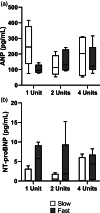Differential effects of speed and volume on transfusion-associated circulatory overload: A randomized study in rats
- PMID: 34396543
- PMCID: PMC9291097
- DOI: 10.1111/vox.13191
Differential effects of speed and volume on transfusion-associated circulatory overload: A randomized study in rats
Abstract
Background and objectives: Transfusion-associated circulatory overload (TACO) is the primary cause of transfusion-related mortality. Speed and volume of transfusion are major risk factors. The aim of this study was to investigate the interaction of red blood cell (RBC) transfusion speed and volume on the development of TACO.
Materials and methods: A validated model for TACO in anaemic Lewis rats with an acute myocardial infarction was used. The effect on pulmonary hydrostatic pressure of one, two or four units of packed RBCs transfused in either 30 or 60 min was evaluated (3.3-26.6 ml·kg-1 ·hr-1 ). Pulmonary capillary pressure was measured as left ventricular end-diastolic pressure (LVEDP). Cardiac stress biomarkers atrial natriuretic-peptide (ANP) and N-terminal pro-brain natriuretic peptide (NT-proBNP) were measured 1-h post-transfusion.
Results: Thirty animals were included (n = 5 per group). Transfusion of RBCs increased LVEDP in a volume-dependent manner (ΔLVEDP [mmHg]: -0.95, +0.50, +6.26, p < 0.001). Fast transfusion increased overall ΔLVEDP by +3.5 mmHg and up to +11.8 mmHg in the four units' group (p = 0.016). Doubling transfusion speed increased ΔLVEDP more than doubling volume in the larger volume groups. No difference in ANP or NT-proBNP were seen in high transfusion volume or groups.
Conclusion: Transfusion volume dose-dependently increased LVEDP, with speed of transfusion rapidly elevating LVEDP at higher transfusion volumes. ANP and NT-proBNP were not impacted by transfusion volume or speed in this model. TACO is seen as purely volume overload, however, this study emphasizes that limiting transfusion speed, as a modifiable risk factor, might aid in preventing TACO.
Keywords: TACO; animal; hemodynamics; pulmonary edema; transfusion reaction.
© 2021 The Authors. Vox Sanguinis published by John Wiley & Sons Ltd on behalf of International Society of Blood Transfusion.
Conflict of interest statement
The authors declare that they have no competing interest.
Figures



Similar articles
-
Volume incompliance and transfusion are essential for transfusion-associated circulatory overload: a novel animal model.Transfusion. 2019 Dec;59(12):3617-3627. doi: 10.1111/trf.15565. Epub 2019 Nov 7. Transfusion. 2019. PMID: 31697425 Free PMC article.
-
Can volume-reduced plasma products prevent transfusion-associated circulatory overload in a two-hit animal model?Vox Sang. 2023 Mar;118(3):185-192. doi: 10.1111/vox.13395. Epub 2023 Jan 4. Vox Sang. 2023. PMID: 36599701
-
Cardiac stress biomarkers after red blood cell transfusion in patients at risk for transfusion-associated circulatory overload: a prospective observational study.Transfusion. 2018 Sep;58(9):2139-2148. doi: 10.1111/trf.14820. Transfusion. 2018. PMID: 30204946
-
Transfusion-associated circulatory overload-a systematic review of diagnostic biomarkers.Transfusion. 2019 Feb;59(2):795-805. doi: 10.1111/trf.15068. Epub 2018 Nov 29. Transfusion. 2019. PMID: 30488959 Free PMC article.
-
The recipe for TACO: A narrative review on the pathophysiology and potential mitigation strategies of transfusion-associated circulatory overload.Blood Rev. 2022 Mar;52:100891. doi: 10.1016/j.blre.2021.100891. Epub 2021 Oct 2. Blood Rev. 2022. PMID: 34627651 Review.
Cited by
-
Transfusion Thresholds and Risk Factors of Acute Kidney Injury in Gastrointestinal Oncology Surgery: Insights from a Retrospective Study.Healthcare (Basel). 2025 Feb 28;13(5):525. doi: 10.3390/healthcare13050525. Healthcare (Basel). 2025. PMID: 40077087 Free PMC article.
-
Platelet transfusion induces transfusion-associated circulatory overload in rats with myocardial infarction.Transfusion. 2025 Jul;65(7):1251-1263. doi: 10.1111/trf.18285. Epub 2025 May 19. Transfusion. 2025. PMID: 40384327 Free PMC article.
-
Acute myocardial infarction and blood transfusion: lessons learned from animal models and clinical studies.Blood Transfus. 2023 May;21(3):185-188. doi: 10.2450/BloodTransfus.427. Blood Transfus. 2023. PMID: 37141620 Free PMC article. No abstract available.
References
-
- Food and Drug Administration : Fatalities reported to FDA following blood collection and transfusion ‐ annual summary for fiscal year 2018. Silver Spring–MD, USA. https://www.fda.gov/media/136907/download 2018. Accessed May 2020.
-
- Narayan S, Bellamy M, Spinks C, Poles D, Mistry H, Carter‐Graham S, et al. The 2019 Annual SHOT Report. https://www.shotuk.org/shot‐reports/report‐summary‐and‐supplement‐2019/ (2020). Accessed Jun 2020.
MeSH terms
Grants and funding
LinkOut - more resources
Full Text Sources
Medical
Research Materials

